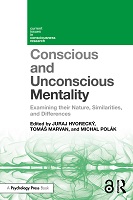Chapter 16 (Un)conscious Perspectival Shape and Attention Guidance in Visual Search
Proposal review
A Reply to Morales, Bax, and Firestone (2020)
| dc.contributor.author | Henke, Benjamin | |
| dc.contributor.author | Weksler, Assaf | |
| dc.date.accessioned | 2023-11-16T09:32:20Z | |
| dc.date.available | 2023-11-16T09:32:20Z | |
| dc.date.issued | 2024 | |
| dc.identifier.uri | https://library.oapen.org/handle/20.500.12657/85154 | |
| dc.description.abstract | When viewing a circular coin rotated in depth, it fills an elliptical region of the distal scene. For some, this appears to generate a two-fold experience, in which one sees the coin as simultaneously circular (in light of its 3D shape) and elliptical (in light of its 2D ‘perspectival shape’ or ‘p-shape’). An energetic philosophical debate asks whether the latter p-shapes are genuinely presented in perceptual experience (as ‘perspectivalists’ argue) or if, instead, this appearance is somehow derived or inferred from experience (as ‘anti-perspectivalists’ argue). This debate, however, has largely turned on introspection. In a recent study, Morales et al. (2020) aim to provide the first empirical test of this question. They asked subjects to find an elliptical coin seen face-on from a search array that also included a circular coin seen either face-on or at an angle. They found that subjects reacted more slowly when the distracting circle was seen at an angle, such that its p-shape matched that of the target ellipse. From this, they concluded that the similar p-shape between the ellipse and circle constituted a phenomenal similarity between the two, and thus that perspectivalism is true. We show that these results can also be explained by pre-attentive guidance by unconscious representations (in what follows, just “unconscious pre-attentive guidance”) and that this explanation is at least as plausible as one from phenomenal similarity. Thus, we conclude that the experiment does not support perspectivalism over anti-perspectivalism. | en_US |
| dc.language | English | en_US |
| dc.subject.other | attention; higher-order theories of consciousness; inattentional blindness; masking; mental qualities; neurophenomenal structuralism; phenomenal content; unconscious mental states | en_US |
| dc.title | Chapter 16 (Un)conscious Perspectival Shape and Attention Guidance in Visual Search | en_US |
| dc.title.alternative | A Reply to Morales, Bax, and Firestone (2020) | en_US |
| dc.type | chapter | |
| oapen.identifier.doi | 10.4324/ 9781003409526- 20 | en_US |
| oapen.relation.isPublishedBy | 7b3c7b10-5b1e-40b3-860e-c6dd5197f0bb | en_US |
| oapen.relation.isPartOfBook | 6b30f474-9a85-45a4-9234-2473310182a0 | en_US |
| oapen.relation.isFundedBy | 7b594309-7322-4938-b810-989a6a6d4872 | en_US |
| oapen.relation.isbn | 9781032529790 | en_US |
| oapen.relation.isbn | 9781032529745 | en_US |
| oapen.imprint | Routledge | en_US |
| oapen.pages | 19 | en_US |
| peerreview.anonymity | Single-anonymised | |
| peerreview.id | bc80075c-96cc-4740-a9f3-a234bc2598f1 | |
| peerreview.open.review | No | |
| peerreview.publish.responsibility | Publisher | |
| peerreview.review.stage | Pre-publication | |
| peerreview.review.type | Proposal | |
| peerreview.reviewer.type | Internal editor | |
| peerreview.reviewer.type | External peer reviewer | |
| peerreview.title | Proposal review |

